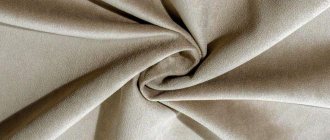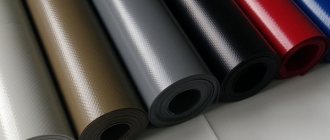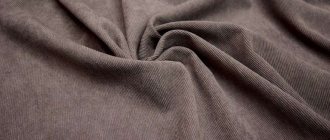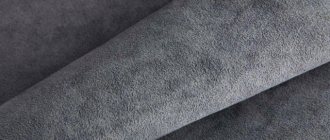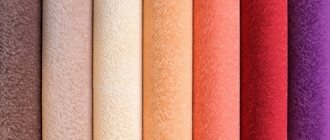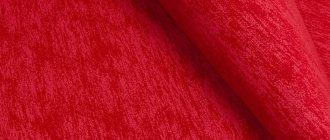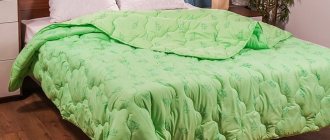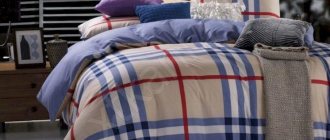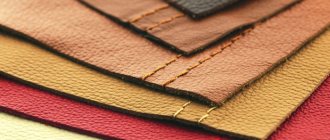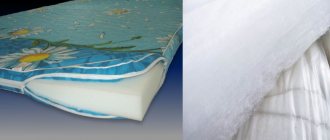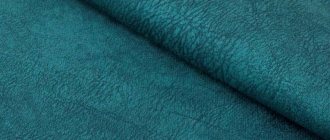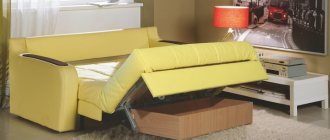The microsuede fabric is pleasant to the touch. It entered the market about 10 years ago thanks to the introduction of the latest developments. Due to a huge number of advantages, furniture microvelor has already conquered more than 60% of the furniture fabric market .
Microvelor fabric usually consists of 2 or 3 layers.
- The top finishing layer is responsible for aesthetics.
- Reinforcing layer - imparts physical and mechanical properties to microsuede. Absent very rarely, but it happens.
- An additional layer that adds volume to the fabric. Due to this, the final product looks better and more expensive. The layer is used only in some furniture models.
Characteristics and composition of fabric
Microvelor furniture fabric is created on a woven base made of cotton, nylon, polyester or a mixture of natural and artificial fibers. The stitches are not W-shaped, but resemble a honeycomb, which affects wear resistance. To obtain a “velvety” effect, a pile of microfibers up to 1 mm long of nylon or nylon is applied to the adhesive base. This is where the name with the prefix “micro” came from. To ensure that the pile is uniform, work is carried out under the influence of an electrostatic field. The material has a special feature - to give better performance properties it is treated with a Teflon compound. In appearance it resembles suede, because the fibers lie in any direction. Being a universal material, microsuede is used for upholstery of sofas and armchairs.
Microvelor for furniture upholstery
Modern upholstery furniture fabric microvelor has the following characteristics:
- abrasion resistant;
- retains its original color for a long time;
- hypoallergenic and antistatic;
- allows air to pass through and repels dust.
Microvelor does not fade in the sun
Characteristics of microsuede material
This is a type of flock that is durable, luxurious in appearance and comfortable to use. His positive qualities:
- has a porous structure, which promotes air circulation;
- environmentally friendly - does not cause allergies;
- antistatic – does not attract dust and pet hair;
- a variety of colors and patterns, the material does not fade over time;
- microvelour does not suffer from exposure to liquids;
- affordable price category.
Disadvantages include the rapid loss of appearance due to fabric abrasion and the need for more careful cleaning compared to flock.
Differences and similarities between velor and micro-velor
Microvelor is a close relative of velor furniture covering; in appearance they are very similar. At the same time, velor and micro-velor have the following differences:
- The length of the pile in microvelor does not exceed 1 mm, in velor it is longer - up to 3 mm.
- The weaving of the base of microsuede is carried out in honeycombs, and its relative is reminiscent of the Latin letter W.
- Furniture velor is a denser fabric than micro-velor.
- Microvelor is treated with a special coating, which makes the material resistant to stains.
What else is the difference between velor and micro-velor? How to iron and wash velor? It is hand washable and can be ironed on the reverse side. Caring for velor is easy, since things made from this material practically do not wrinkle. A velor sofa in the interior will create a feeling of comfort throughout the room. But it is very sensitive to mechanical damage. Cat's claws will seriously ruin the appearance.
You might be interested in: Making flowers from wool threads with your own hands step by step
Velor sofa
Difference from other materials
The main difference is the manufacturing technology. It is different from the procedure for creating velvet, but similar to making flock. This fabric is made by weaving honeycombs, so it is practical and abrasion resistant.
Advice! It is advisable to choose textiles with fine pile and dense upholstery, then they will last a long time and look good.
Unlike other materials, microsuede is easy to clean. No stains are scary for him. It has a special coating that does not absorb dirt and does not attract dust. The material needs care, it is advisable to clean it at least once a week, then it will look like new.
If you are wondering which is better: velor or micro-velor, then the answer is clear - the second option is more practical and durable. It is he who is rapidly replacing velor. The characteristics of this furniture fabric attract users, so the demand for textiles is growing. Housewives value it for its wear resistance and strength.
Comparison with other upholstery materials
Another popular material for furniture upholstery is flock.
It has the following advantages:
- pleasant to the touch;
- durable, resistant to pet claws;
- does not cause allergies;
- moisture resistant;
- Resistant to fading.
The pile is longer than that of microvelor, but the base is non-woven.
Sofa with flock upholstery
No less famous is chenille - a woven, extremely durable material with a velvety surface.
Has the following characteristics:
- increased wear resistance;
- environmental friendliness;
- color fastness;
- pleasant to the touch fabric.
The disadvantage is the ability to absorb water very well.
Chenille sofa
Matting is an equally popular upholstery material.
The main distinguishing feature is the rough weaving of threads of different density and texture. The result is a checkerboard relief with an attractive texture. She is a close relative of chenille.
What is better - microvelor, flock, matting or chenille? This is a matter of taste and wallet. But it is important to keep in mind that it is better not to use a matting if there is a cat or dog in the house.
Matting upholstery
Important information! Flock and microvelor are also close relatives. They are created using the same technology by spraying short pile onto the base. They look and feel like velvet. Both have a water-repellent surface.
Microvelor production technology
This production technology has replaced flocks. Flock fabric was relatively expensive and inconvenient to produce. To produce fabric with a pile (high or low), varnishing of materials is no longer required. The pile is applied using a magnetized field and attached to the base .
Microvelor consists of 100% polyester, which allows you to give it any color. After further processing, it can be given texture, pile height, and a pattern (using heat treatment). Technologists are achieving the texture of artificial suede or even artificial leather. All this expands the scope of application of furniture microvelor.
Where to put furniture with microvelor upholstery
Since the fabric absorbs odors and cannot be washed, the best place for furniture with micro-velor upholstery would be the living room or bedroom.
For the living room, you can choose any color you like and thus complement the interior with bright colors. For a bedroom, the choice will be successful, since usually no one else sits on the furniture except the owners themselves. It will last longer.
It is better to purchase leather furniture for the hallway, since it is easier to remove dirt from it. In the kitchen and dining room there is a high risk of staining the upholstery with food.
Modern sofas with microvelor upholstery come in the following types:
- Straight - a classic, standard rectangular sofa.
- Corner - fits comfortably into a small room, can be folded out and used as an extra bed.
- Island units are an ideal option for spacious rooms; they can be placed in the center of the room.
You may be interested in what kind of fabric is used for sewing bedspreads
A popular type of finishing is carriage screed. Furniture upholstery is stitched with buttons to create a diamond-shaped pattern, reminiscent of the upholstery in a royal carriage.
Island sofa
Sofa with microvelor: what rooms is it suitable for?
This fabric is good for different rooms: hallway, living room, bedroom.
Advice! It is better not to buy sofas with microvelor for the dining room and kitchen, as they will have to be washed frequently due to food contamination. Also, textiles will absorb food odors.
A sofa with such a covering is suitable for a hallway, but it is recommended to choose leather options for such a room, since they are easier to clean and keep their presentable appearance longer.
It is best to purchase designs with this material for the living room. There, the sofa will decorate the room, stylishly complementing the interior.
In the bedroom, a sofa with microvelor will last a long time, since only the owners will sit on it.
Fabric care
The fabric does not require too much attention to itself. Standard vacuuming is sufficient to remove dust and dirt. Can't be washed or wet. This can damage the Teflon coating. Stains from food, toothpaste, and sauces can be successfully removed with a damp cloth or cloth soaked in soapy water. You can prepare a baking soda solution.
Furniture cleaning
Before cleaning furniture, you need to decide what means the manufacturers allow for it. The label may contain the following markings:
- W - you can use a water-based product;
- S - the product must be alcohol-based;
- SW - the cleaning agent can be either water-based or alcohol-based.
To clean furniture you will need:
- detergent selected according to the label description;
- spray;
- sponge;
- paper towel or clean cloth;
- vacuum cleaner with various attachments (brushes).
Cleaning furniture
Cleaning sequence:
- Collect crumbs, dust, debris from the surface with a vacuum cleaner with a soft brush, clean all corners.
- Test the effect of the cleaning agent on a small and inconspicuous area of the upholstery. Spray, blot with a clean cloth and leave to dry. After an hour, check this place - there should be no changes in the color or texture of the fabric.
- If the product is suitable, apply it to stains and dirty areas, wipe with a sponge or towel. They should always be clean so as not to spread dirt all over the sofa.
- Leave to dry.
- Smooth out the material with a soft brush.
Important information! It is necessary to immediately wipe off any stains that have formed and do not allow them to be absorbed into the fabric. Old dirt can be wiped with alcohol or vodka. Vacuuming is necessary once a week.
By following simple maintenance rules, you can significantly increase the service life of furniture finishing.
You may be interested in: Is it possible to make liquid skin yourself and how to use it?
Removing stains from furniture
Advantages and disadvantages
The advantages of the fabric are as follows:
- eco-safety - the fabric does not harm the environment and health;
- strength;
- moisture resistance;
- huge selection of colors;
- resistance to burnout;
- budget price.
There are few disadvantages:
- requires special care;
- some species are of low quality
Wide range of colors to suit every taste
Advantages of microsuede fabric for manufacturers
- Various densities . The manufacturer himself can choose the density of the fabric, depending on his needs.
- Design . Furniture manufacturers receive a huge color card, a large selection of textures and several quality options. Thin microvelor for economical furniture and with an additional backing for middle and high class furniture.
- Convenience at work . It doesn't fray, so you don't have to overlock the edges.
- Physico-mechanical properties . The fabric is elastic and stretches, which is important for manufacturers of upholstered furniture. The micro-velor upholstery stretches over the uniform and fits it well.
- Easy to cut and easy to sew .
- Anti-vandal microvelor . All fabric collections are resistant to animal claws. By additional processing, a moisture- and dirt-resistant fabric is obtained. Such processing can be done in a factory, but it is also possible to process a finished product in production.
